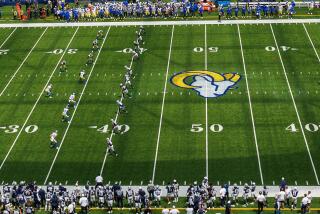Following the Latest Trends, NFL Teams Now Look for Even Bigger Linemen and Ever Smaller Receivers
- Share via
Other than fashion designers and comedians, there may not be a more zealous bunch of copycats in the world than football coaches.
It apparently takes only a matter of days for a new joke or a new hemline to make it from New York to Pomona. The travel time is not much greater for an idea that has had success on the football field.
If the Cincinnati Bengals do something particularly clever one Sunday, every high school team in Ohio might be trying it the following weekend.
On a recent morning in the training camp of the Dallas Cowboys, Coach Tom Landry was surveying a group of 20 wide receivers running their routes. Most of them were free agents and most of them were of the smallish variety.
“You know how it is with trends,” said Landry. “Miami had success with small receivers and now everybody will be trying to find one.”
Trends come and go in the NFL, but among those currently in vogue are:
--A king-sized line and a one-back offense to go with it, popularized by John Riggins and his beefy teammates with the Washington Redskins.
--Swift, small receivers such as Mark Clayton and Mark Duper--the Miami speedsters who combined last year to catch 144 passes for 2,695 yards and score 26 touchdowns.
--A controlled passing attack, something which San Francisco coach Bill Walsh parlayed into a “genius” tag but which had been used for years before by Brigham Young coach LaVell Edwards.
--Situation substitution, chiefly used on defense where as many as five, six or seven players leave the field and are replaced by those better suited for whatever the situation might be.
Football is and always has been a changing game. For the most part the change comes about through an evolutionary process--the players get bigger, coaches create new methods of advancing the ball and other coaches figure out ways to stop them.
But the event which has led to many of the recent radical changes came about in a meeting room in 1978. That was the year NFL owners agreed to a series of rules changes, the most telling one being a limitation of contact between pass defenders and pass receivers.
As soon as offensive coaches began making adjustments, the results were obvious. More passes were thrown, more were completed and more points were scored. With receivers less apt to be knocked around, it was possible for smaller and quicker pass catchers to have success--as became obvious last year with Duper and Clayton.
In 1977 an average of 34 points were scored in each NFL game and that average was beefed up by two particularly high scoring teams--the Oakland Raiders and Dallas Cowboys.
In 1983 that average had climbed to almost 44 points a game.
The rules changes were made in the first place because of a fear the game had grown too defensive and too dull. Now there seems to be a big play every minute.
As the yardage and point totals increased, league owners began to discuss the possibility of rolling back some of the rules changes which caused such an escalation of offense.
“But I think it was generally felt,” said NFL competition committee chairman Tex Schramm, “that the coaches would eventually even things out. It’s been my experience that no matter what the rules are, if an offensive coach does one thing a defensive coach will eventually figure out ways to counter.”
Part of the defensive strategy has been the increased use of pass-defense alignments on first down. In some situations teams resort to six and seven defensive backs on first down.
Sure enough, there was a slight reduction in the league’s overall point total last year. In 1983 there were 9,779 point scored. Last year there were 9,502.
The use of excess defensive backs and an increase in the number of blitzes was one of the trends developing in 1984. The results show that trend was successful.
Somewhere this year, therefore, some team may choose to use 10 defensive backs and rush seven of them. And if it works, most of the teams in the league will be doing it seven days later.
More to Read
Go beyond the scoreboard
Get the latest on L.A.'s teams in the daily Sports Report newsletter.
You may occasionally receive promotional content from the Los Angeles Times.










